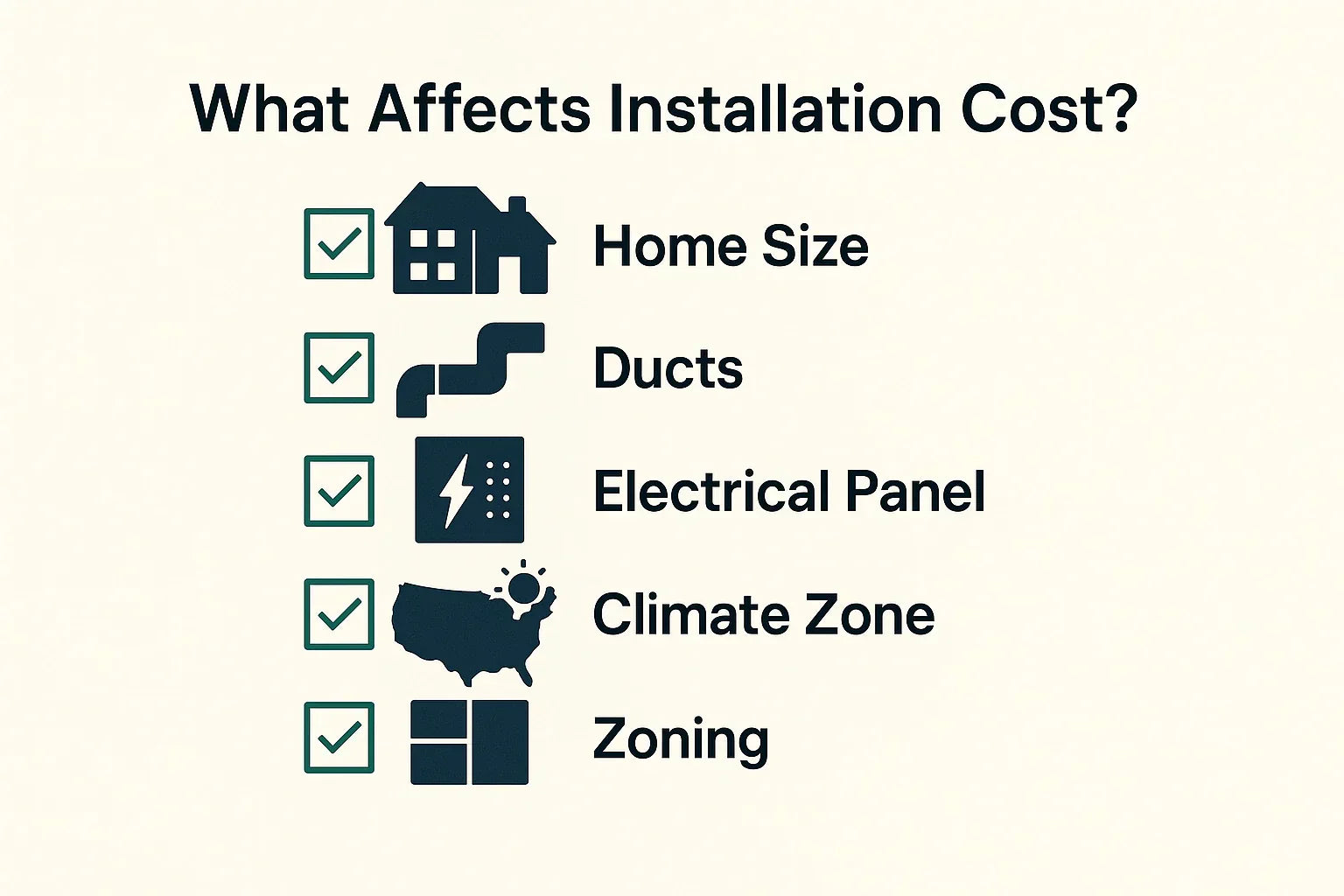Thinking about switching to a cold climate heat pump? Good move. These systems offer impressive efficiency, all-electric heating, and year-round comfort — even in freezing weather. But let’s be real: one of the first questions homeowners ask is, “How much is this going to cost me to install?”
In this guide, I’ll break down the 2025 installation costs for cold climate heat pumps, what factors affect pricing, and how to lower your total investment through smart choices and rebates. Whether you're replacing a furnace or upgrading an old AC system, here’s what you need to know before signing a contract.
Average Cold Climate Heat Pump Installation Costs (2025)
As of 2025, here’s what most homeowners can expect to pay for a professional cold climate heat pump installation:
| System Type | Average Installed Cost |
|---|---|
| Cold Climate Ducted | $12,000–$18,000 |
| Cold Climate Ductless (Mini-Split) | $8,000–$15,000 |
| Dual-Fuel Hybrid System | $14,000–$22,000 |
These figures include labor, permitting, line sets, thermostat setup, and refrigerant charge. Keep in mind: high-performance units designed for northern climates cost more than standard models — and that’s not a bad thing. They’re built to keep you warm when the mercury drops below zero.
📘 For a deeper look at electrification pricing, check out Rewiring America’s 2025 Guide to Home Upgrades.
What Drives Installation Costs?
Not all installs are equal. Here’s what determines whether your project lands closer to $8,000 or $22,000:
Home Size and Layout
-
Larger homes require larger-capacity systems or multi-zone setups
-
Multi-story homes may need extra refrigerant line runs or air handlers
-
Open-concept layouts are easier to heat with fewer indoor heads
📘 According to Carrier, installation costs often vary based on heat pump size — with larger-capacity systems (2 to 5 tons) and more zones leading to higher overall prices.
Ducted vs. Ductless
-
Ducted systems require connections to existing ductwork — which may need sealing or repair
-
Ductless mini-splits avoid duct issues but need multiple indoor heads for whole-home coverage
Electrical Panel Upgrades
Cold climate heat pumps often require a dedicated 240V circuit and, in some cases, a new 200-amp panel — especially in older homes.
-
Panel upgrade: $2,000–$4,000
-
Permit and inspection fees: $200–$800
📘 The U.S. Department of Energy highlights electrical infrastructure as a common upgrade required during heat pump installations.
Climate Performance Features
Units designed for sub-zero performance include:
-
Inverter-driven compressors
-
Cold-weather refrigerants
-
Insulated outdoor cabinets
-
Integrated defrost cycles
These features add $2,000–$4,000 compared to base models — but they’re essential for reliable heating below 20°F.
Add-Ons That Increase Cost
Beyond the core system, here are common extras that can increase your bill:
-
Smart thermostats like Ecobee or Nest: $200–$400
-
Wall brackets, line hide kits, or snow hoods: $300–$800
-
Backup electric heat strips or gas integration (for dual-fuel setups): $500–$2,000
-
Longer line sets or attic runs: $300–$1,200
📘 For installation prep details, see HVAC.com’s Homeowner Heat Pump Checklist.
Ways to Save on Installation
The good news? There are several ways to reduce your upfront investment — without cutting corners.
Leverage 2025 Rebates and Tax Credits
-
Federal Tax Credit (IRA): Up to $2,000 on qualifying heat pumps
-
Utility Rebates: $500–$2,000 based on location
-
State Incentives: Available in areas like NY, MA, CA, CO
📘 Find programs near you using ENERGY STAR’s Rebate Finder.
Compare Multiple Quotes
Always get at least 2–3 bids from licensed HVAC contractors. Ask for:
-
A Manual J load calculation
-
Breakdown of equipment and labor
-
Warranty details
-
Brand and model specs
Phase Your Installation
Can’t do the whole house at once? Install a single-zone system in your primary living space, then expand later. Ductless mini-splits are great for this.
What’s Worth Paying For?
Some things are worth the extra cost:
-
Inverter technology – quieter, more efficient, better cold weather performance
-
High HSPF2/SEER2 ratings – long-term energy savings
-
Reputable installer – ensures proper sizing, airflow, and refrigerant charging
-
Warranty coverage – peace of mind for 10–12 years
Cut corners here, and you risk poor performance, higher bills, or premature system failure.
Final Thoughts from Alex Lane
Cold climate heat pumps aren’t cheap — but they’re an investment in your comfort, energy savings, and resilience for years to come. And in 2025, the rebates, tech improvements, and growing installer network make it one of the smartest upgrades you can make.
Just be sure to:
-
Ask the right questions
-
Compare quotes carefully
-
Use rebates to your advantage
-
Size it right for your home and climate
👉 Want to compare the most efficient models available this year? Read the full guide:
🔗 Best Heat Pumps for Cold Climates in 2025
👉 Concerned about snow and frost interfering with performance? Learn how your system stays operational through sleet and ice in our next article:
🔗 Defrost Mode Demystified: How Heat Pumps Handle Ice in Freezing Weather
Alex Lane
Your Home Comfort Advocate







